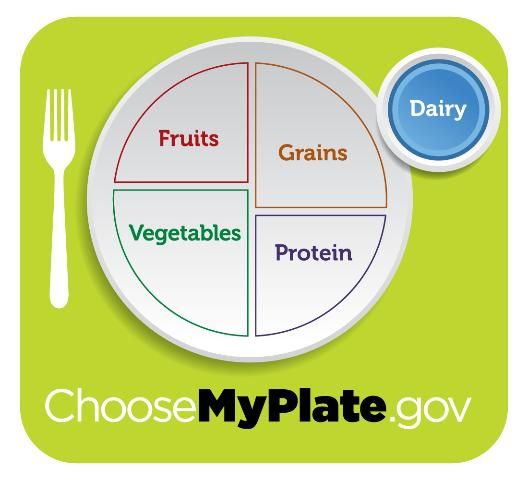
Credit: Justin Doub. CC BY-NC-SA 2.0. https://flic.kr/p/2kMbsZ
Yogurt has become a popular item in the American diet. It has literally taken over the dairy section in many stores. Have you ever wondered about how yogurt is made, its health benefits, or the differences among the various types of yogurt available? Keep reading to find the answers to these questions and to learn even more about yogurt.
What is yogurt?
Yogurt is a dairy product made by adding live and active bacterial cultures to milk to cause fermentation. Fermentation changes some of the lactose, the sugar naturally present in milk, to lactic acid. This creates a creamy texture and tart flavor. The texture and flavor of yogurt can vary depending on the bacterial culture, the straining process or the type of milk used (whole, low-fat, or fat-free), as well as the flavoring or other ingredients added.
Why is yogurt important for health?
Yogurt provides many of the nutrients that the body needs for good health (USDA n.d.-c). These nutrients include calcium and potassium. Calcium helps maintain bone health and potassium helps with blood pressure control. Some yogurts have vitamin D added, which enhances calcium absorption and helps with immune function. The protein in yogurt helps to build and repair muscle. Some yogurts may also promote digestion and gut health (Morelli 2014). Yogurt is included in the Dairy Group of MyPlate, the USDA guide to healthy lifestyles for consumers (USDA n.d.-b).

At MyPlate.gov, it is recommended that people over nine years of age consume 3 cups of Dairy each day (USDA n.d.-a). A cup is equal to 8 ounces of yogurt. Single-serving yogurts most often come in 6-ounce containers, which is equal to ¾ cup.
Live and Active Cultures
Lactobacillus bulgaricus and Streptococcus thermophilus are the most common cultures used to make yogurt. All yogurts start out with live and active cultures, but some yogurts are heat-processed after fermentation is complete, which kills the bacteria. If the product contains live and active cultures, they are considered ingredients and therefore must be listed on the label (National Yogurt Association n.d.).
The National Yogurt Association, a non-profit trade organization of the dairy industry, has created a Live & Active Cultures seal that approved manufacturers can voluntarily place on the packaging if their product meets the requirements.

Credit: Trademark of the National Yogurt Association
Some yogurts with live and active cultures offer additional health benefits, which may include improved digestive health (Morelli 2014).
Fat Content of Yogurt
Yogurt, like milk, is available in whole, low-fat, and fat-free varieties. Whole-milk yogurt contains 3.25% fat, low-fat yogurt may contain between 0.5% and 2% fat, and fat-free yogurt contains less than 0.5% fat (USDA n.d.-c). Table 1 lists the amounts of fat in yogurts made from whole, low-fat, or fat-free milk. When selecting yogurt, consider choosing a low-fat or fat-free product. Both offer all the nutritional benefits of yogurt without the added calories from fat.
Lactose Content of Yogurt
Many people lack the enzyme lactase, which is required to digest lactose. Because of this, they have trouble digesting foods containing lactose. This can lead to symptoms such as gas and bloating. People with this problem tend to have fewer symptoms when they consume yogurt as compared to milk (Savaiano 2014).
Flavored Yogurt
When reading the Nutrition Facts label for yogurt, some people are surprised to see that even plain yogurt contains sugar. The sugar content listed on the label represents any remaining lactose and the amount of sugar added for flavor. Lactose is the naturally occurring sugar in milk products. In plain yogurt, the sugar content will be from lactose only.
Sweetened yogurts, those with sugar or sugar substitutes added to them, come in many flavors. Popular flavors include vanilla, strawberry, peach, and other fruit flavors. Some yogurt manufacturers have released innovative flavors such as "red velvet cake" and "apple pie." Many fruit-flavored yogurts are also available in "fruit-on-the-bottom" versions. These may be higher in sugar than pre-mixed varieties.
Sweeteners commonly used in yogurt include fructose, sucrose (table sugar), or high fructose corn syrup. These added sugars increase the caloric content of the product. "Light" varieties of flavored yogurts usually contain high-intensity sweeteners, such as sucralose, that do not increase the calorie content.
Types of Yogurt
Traditional Yogurt
Traditional yogurt has a creamy texture and tart taste. Traditional yogurts are available in many flavors and textures. They also come in whole-milk, low-fat, and fat-free varieties. Many supermarkets sell their own line of traditional yogurts that may be less expensive than name-brand versions.
Greek Yogurt
Greek yogurt is created when traditional yogurt is strained multiple times to remove some of the liquid. The result is a concentrated, thick, and tart product with more protein per serving than traditional yogurt, but with less calcium. It also contains less lactose because some is removed with the liquid. Greek yogurt may be more suitable for people with lactose intolerance because most are lower in lactose, and some brands are lactose-free. Table 1 compares the nutritional content of Greek yogurt to that of traditional yogurt. As with traditional yogurt, there are several manufacturers of Greek yogurt with different manufacturing processes and ingredients.
Probiotic Yogurt
While most yogurts contain live and active cultures, some also contain cultures that have demonstrated health benefits beyond nutrition (FAO and WHO 2002). Probiotics are live bacteria with known health benefits (FAO and WHO 2002). Some manufacturers add probiotics to their yogurts. Most probiotic yogurts are marketed as digestive aids or for immune support. Probiotic yogurts typically have nutrient contents similar to those of traditional yogurts and come in different varieties.
Drinkable Yogurt
Drinkable yogurts offer the benefits of yogurt without the need for a spoon. It is a great option for people on the go or for those who do not enjoy the texture of firmer yogurts. They are made by adding water and additional flavors to traditional yogurt. Drinkable yogurts offer the same nutrients as traditional yogurts but may be higher in sugar and calories.
Organic Yogurt
Organic yogurt is produced from organic milk. An item may be considered organic only if it meets certain standards, including limited or no use of most pesticides, hormones, chemical fertilizers, or antibiotics at any stage of production. For example, ingredients used in animal feed must have been grown using a limited number of approved pesticides and chemical fertilizers, if any, and the animals producing the milk must not have been treated with hormones or antibiotics (USDA n.d.-d). Organic products tend to cost more, but they have increased in popularity with some consumers for perceived health and environmental reasons.
Non-Dairy Yogurt
Non-dairy yogurts are an alternative for those with milk allergies and those who experience gastrointestinal problems as a result of consuming dairy-based yogurt products. They are also a good option for people who do not consume dairy products because of religious or personal beliefs. Yogurts made from soy milk can usually be found at a local grocer. These products have similar nutritional profiles to yogurts made from milk if they have been fortified with nutrients such as calcium and vitamin D. While some manufacturers of non-dairy yogurts use live and active cultures for fermentation, others do not.
Kefir
There are several other fermented milk products in addition to yogurt. Kefir is an example of a non-yogurt, fermented milk product. Like yogurt, kefir contains live cultures. It is produced when "kefir grains," which contain yeast and acid-forming bacteria, are added to milk and fermentation occurs (Güzel-Seydim et al. 2000). This produces a slightly carbonated, fermented milk drink. The nutritional benefits of kefir are similar to those of yogurt and health benefits may include improved gastrointestinal and immune function (Güzel-Seydim et al. 2011).
Ways to Eat Yogurt
Yogurt can make a great snack or addition to a balanced breakfast. Try using yogurt instead of milk with cereal. You can spoon granola and fruit over your favorite yogurt for a delicious treat or put yogurt in smoothies to make them creamy. Try using plain yogurt instead of mayonnaise or sour cream in recipes as a healthier and more nutritious ingredient.
Be an informed shopper!
You may have noticed that the yogurt section at your local grocery store is large. Walking down this aisle can be overwhelming because of the many different types of yogurts available. You may find that some yogurts better meet your needs and preferences than do others.
Just as yogurts come in an assortment of types and flavors, the price of yogurt also varies. Since yogurt is often on sale at the grocery store, make sure you check the weekly specials. Buying yogurt in larger containers versus single-serving containers will save you money as well.
When buying yogurt, make sure you check the "sell-by" date on each package as grocers tend to place items that are close to their expiration date at the front of the shelf. Yogurts may be consumed up to two weeks after the "sell-by" date (Garden-Robinson 2018). Remember, yogurt must be refrigerated to maintain quality and safety.
Learn More about Food and Nutrition
To learn more about yogurt and other nutrition-related topics, contact your local UF/IFAS Extension Family and Consumer Sciences (FCS) agent. A registered dietitian nutritionist (RDN) also can provide you with reliable information on nutrition.
References
Food and Agriculture Organization of the United Nations, and World Health Organization (FAO and WHO). 2002. "Guidelines for the Evaluation of Probiotics in Food; Report of the Joint FAO/WHO Working Group on Drafting Guidelines for the Evaluation of Probiotics in Food." https://www.who.int/foodsafety/fs_management/en/probiotic_guidelines.pdf
Garden-Robinson, Julie. 2018. "Food storage guide, answers to questions." Accessed December 19, 2019. https://www.ag.ndsu.edu/publications/food-nutrition/food-storage-guide-answers-the-question
Güzel-Seydim, Z., T. Kok-Tas, A. Greene, and A. Seydim. 2011. "Review: Functional properties of kefir." Critical Reviews in Food Science and Nutrition 51 (3):261–268. doi: 10.1080/10408390903579029.
Güzel-Seydim, Z., A. Seydim, A. Greene, and A. Bodine. 2000. "Determination of organic acids and volatile flavor substances in kefir during fermentation." Journal of Food Composition and Analysis 13 (1):35–43. https://doi.org/10.1006/jfca.1999.0842
Morelli, L. 2014. "Yogurt, living cultures, and gut health." American Journal of Clinical Nutrition 99 (5 Suppl):1248s–50s. doi: 10.3945/ajcn.113.073072.
National Yogurt Association. n.d. "Live & active culture yogurt." Accessed February 15, 2022. https://sofunyogurteaston.com/live-active-culture-yogurt/
Savaiano, D. 2014. "Lactose digestion from yogurt: Mechanism and relevance." The American Journal of Clinical Nutrition 99 (5):1251S–1255S. doi: 10.3945/ajcn.113.073023.
United States Department of Agriculture (USDA). n.d.-a. "All About The Dairy Group." Accessed February 13, 2023. https://www.myplate.gov/eat-healthy/dairy
United States Department of Agriculture (USDA). n.d.-b. "Choose MyPlate." Accessed December 19, 2019. https://www.myplate.gov
United States Department of Agriculture (USDA). n.d.-c. "FoodData Central." Accessed December 19, 2019. https://fdc.nal.usda.gov/
United States Department of Agriculture (USDA). n.d.-d. "Organic Regulations." Accessed December 19, 2019. https://www.ams.usda.gov/rules-regulations/organic